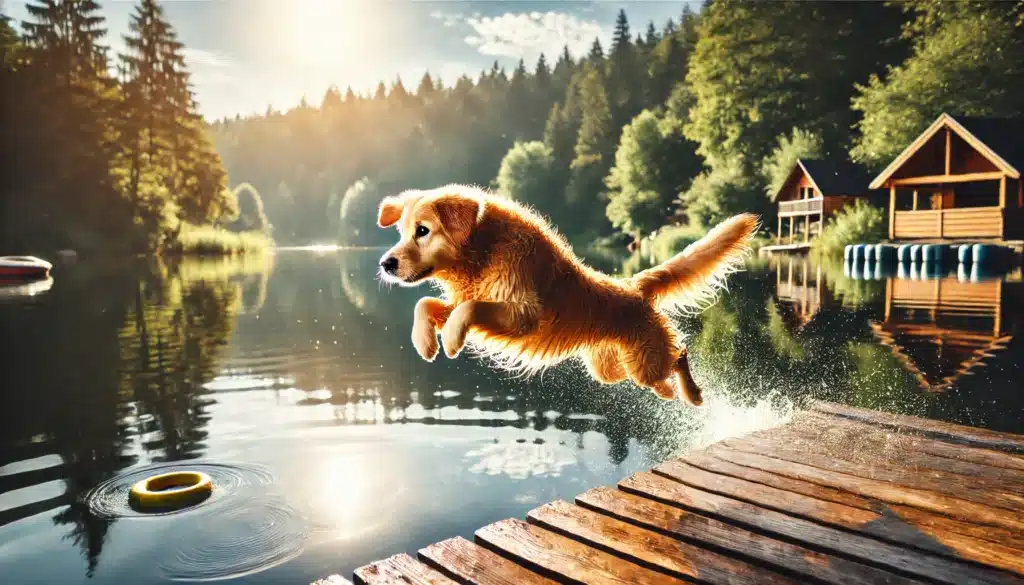
Golden Retrievers have long been celebrated for their friendly demeanor, intelligence, and unmistakable golden coats. These beloved family pets possess an inherent love for water that transcends mere enjoyment; it’s deeply rooted in their evolutionary background.
As one of the most popular dog breeds in the world, Golden Retrievers not only fit into the family dynamic seamlessly but also thrive in aquatic environments. In this article, we will explore the amazing swimming traits that make Golden Retrievers exceptional companions for diving into water adventures in 2025 and beyond.Evolutionary Background
Golden Retrievers trace their origins back to the 19th century in Scotland, where they were carefully bred for hunting and retrieving game from water. Their development was a result of crossbreeding between the now-extinct Yellow Water Spaniel and the Tweed Water Spaniel, along with Irish Setters and Bloodhounds. This unique lineage instilled in them not only the drive to retrieve but also the physical attributes that make them adept swimmers.
Over generations, Golden Retrievers have developed remarkable adaptations for aquatic environments. Their webbed toes provide enhanced propulsion in the water, allowing them to swim with remarkable efficiency. Coupled with their water-repellent double coat, these dogs are designed to be comfortable in various water temperatures without becoming waterlogged. Compared to other breeds known for their swimming prowess, such as Labrador Retrievers and Portuguese Water Dogs, Golden Retrievers stand out not just for their physical capabilities, but for their buoyant personalities that shine when they’re near water.
Physical Traits Enhancing Swimming Ability

The structure of Golden Retrievers is tailored for swimming excellence. Their muscular build, with strong hindquarters, allows them to generate power as they paddle through the water. This physical design is complemented by their buoyancy, enabling them to glide effortlessly. When you watch a Golden Retriever swim, you can appreciate the harmony of strength and grace that defines their aquatic movements.
Equally important is their fur composition. Golden Retrievers possess a distinctive double coat: a thick, water-repellent outer layer that helps keep them dry and an insulating underlayer that protects them from cold water. This unique fur structure prevents them from becoming saturated and allows for longer, more enjoyable swim sessions. Additionally, their long, otter-like tail plays a crucial role as a rudder, helping to steer and stabilize them as they navigate through water. It’s a marvel of nature, contributing to their effortless swimming style.
Behaviors and Instincts

Golden Retrievers are naturally inclined to love water, displaying an instinctual urge to retrieve objects tossed into lakes and rivers. This behavior traces back to their hunting roots, where their role was to fetch game from water. Many owners have experienced the joy of watching their Golden eagerly leap into the water after a thrown ball or toy, demonstrating their enthusiasm and drive.
Their social nature and playful spirit make them the perfect companions for aquatic activities. Golden Retrievers thrive in environments where they can interact with humans and other dogs, especially during playtime in the water. To safely introduce your Golden Retriever to swimming, it’s best to start in shallow, calm waters where they can gradually acclimate to the experience. Positive reinforcement techniques, like treats and praise, go a long way in ensuring they develop a love for this activity.
Here’s a helpful video demonstrating how to introduce a Golden Retriever to swimming:
Health Considerations for Aquatic Activities
While the love for water can be a source of joy, it’s essential to remain mindful of health considerations that may affect Golden Retrievers during swimming activities. Common issues such as hip dysplasia and ear infections can arise from extended water exposure. Hip dysplasia, in particular, can exacerbate discomfort when swimming, so it’s important to monitor your dog’s activity levels and consult a veterinarian if you notice signs of discomfort.
To ensure your Golden stays safe while enjoying aquatic adventures, proper supervision is paramount. Always keep a close eye on your dog, especially in deeper waters, and ensure they have access to fresh water to stay hydrated. Additionally, protecting their ears from excess water can help prevent infections, so consider using ear protection or drying their ears after swimming.
Post-swim care is also critical. After a fun day of swimming, make sure to rinse your Golden Retriever with fresh water to remove any chlorine or salt residue, which can irritate their skin. Dry them thoroughly with a towel, paying special attention to their ears and between their toes to prevent moisture-related issues.
The Role of Golden Retrievers in Aquatic Activities

With their swimming prowess, Golden Retrievers excel in various water sports and activities. Dock diving is a popular choice, where these dogs leap off platforms to retrieve objects from the water. Their natural retrieving instincts shine in activities like water retrieval, where they showcase their skills in bringing back items from lakes and rivers. Additionally, agility courses that incorporate water elements provide an exciting challenge for these energetic dogs.
Golden Retrievers are not only skilled athletes; they are also utilized in therapeutic roles involving water. Many therapy dogs have been trained to work alongside individuals with disabilities, providing emotional support and companionship during swimming sessions. Their calm demeanor and natural affinity for water make them well-suited for these important roles, showcasing their versatile nature.
Statistics reveal that Golden Retrievers often excel in water-based competitions, consistently ranking among the top breeds in events like water retrieval trials. Notable success stories include individual Golden Retrievers who have earned titles and accolades, highlighting the breed’s exceptional abilities in aquatic sports. This recognition further cements their status as one of the premier water-loving breeds.
Conclusion
Golden Retrievers truly embody the essence of aquatic adventure. Their unique swimming traits, from their evolutionary adaptations to their playful personalities, make them natural swimmers and cherished companions for water activities. As we look ahead to 2025, it’s essential for dog owners to engage responsibly with their Golden Retrievers in safe aquatic environments. By understanding their needs and celebrating their love for water, we can create lasting memories filled with joy, laughter, and splashes. So grab a ball and head for the nearest lake—your Golden Retriever is ready for an adventure!




